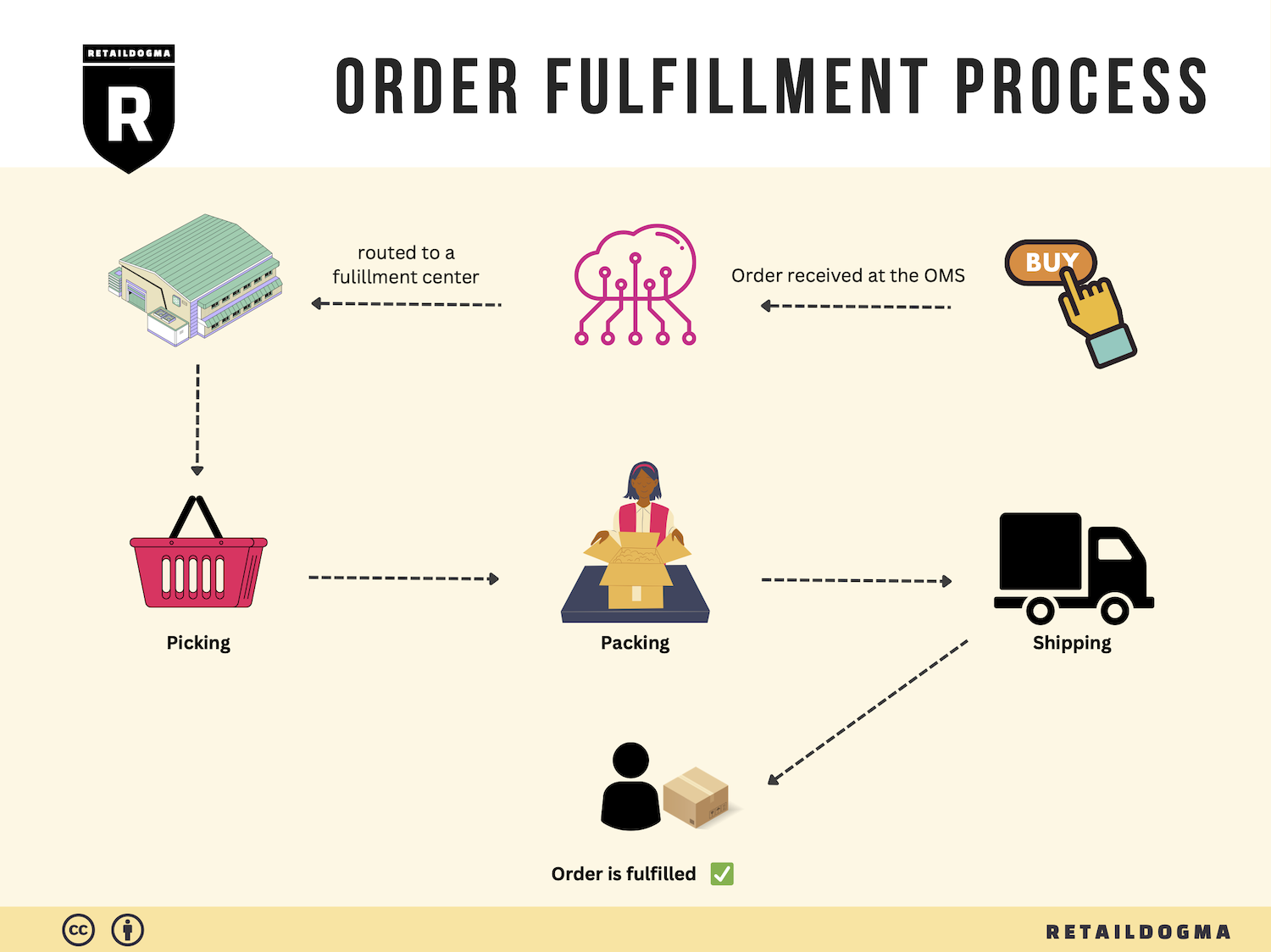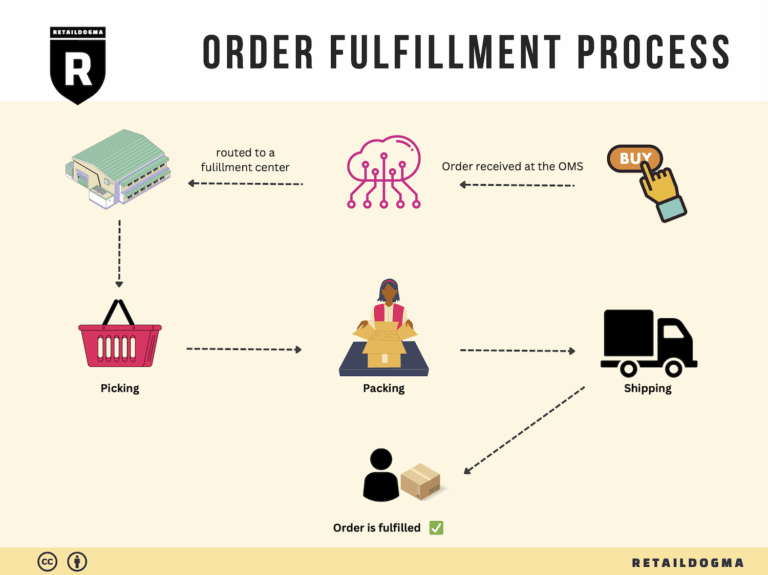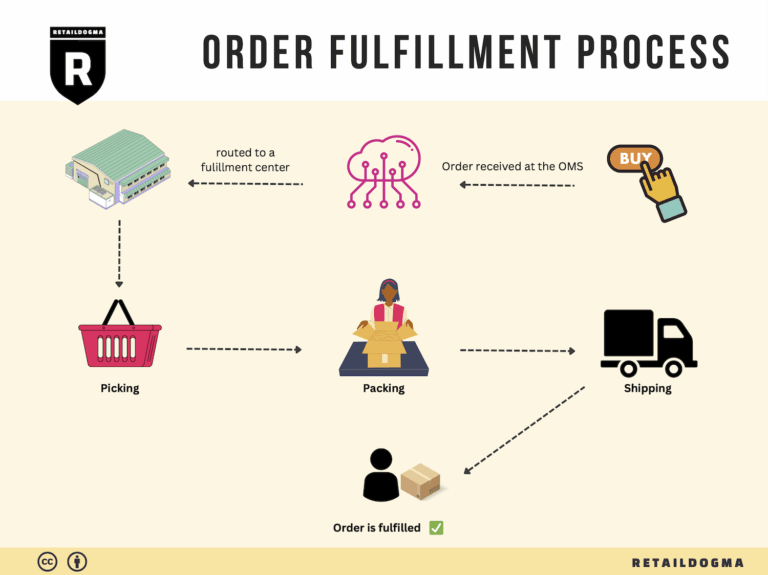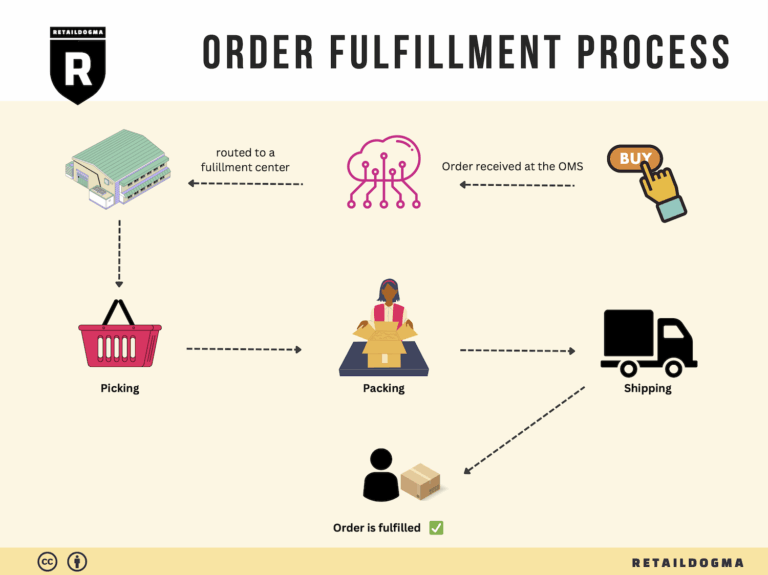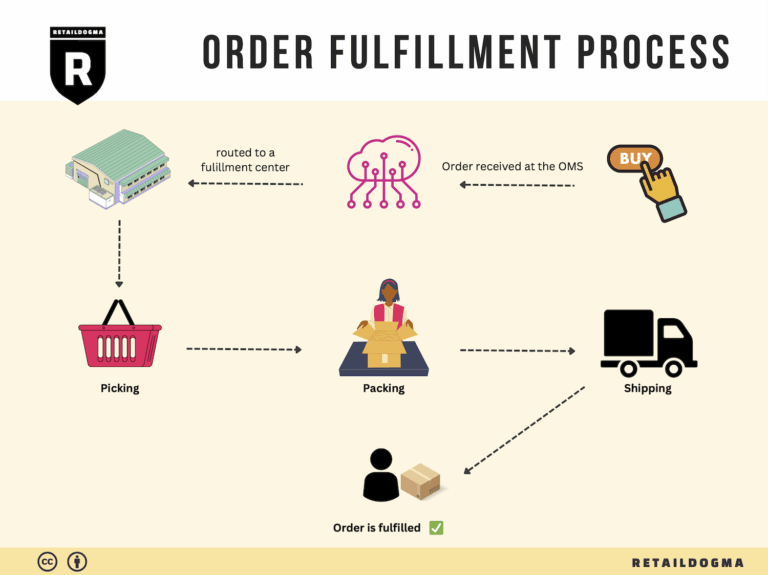Ecommerce Fulfillment Services: The Ultimate Guide (2025)
What is E-commerce Fulfillment? An Introduction for Growing Businesses
Understanding the Challenges of E-commerce Fulfillment
As your online business begins to grow, the excitement of increasing sales can quickly turn into the stress of managing logistics. One of the most common pain points for e-commerce business owners is the overwhelming task of packing and shipping orders. The process can become chaotic, especially as order volume increases, leading to potential delays and dissatisfied customers. This is where effective e-commerce fulfillment comes into play.
Defining E-commerce Fulfillment
At its core, fulfillment is the process of getting a product from your warehouse or fulfillment center to your customer’s doorstep. It encompasses several key steps, including inventory management, order processing, packing, shipping, and handling returns. A well-structured fulfillment process is crucial for maintaining customer satisfaction and operational efficiency as you scale your business.
What This Guide Will Cover
This guide aims to demystify e-commerce fulfillment and provide you with the insights you need to make informed decisions about your logistics. Here’s what you can expect to learn:
-
Fulfillment Models: We will explore different fulfillment models, including Third-Party Logistics (3PL) and Fulfillment by Amazon (FBA). Each model has its own advantages and considerations, and understanding these can help you choose the right fit for your business.
-
Core Services: We’ll break down the essential services involved in fulfillment, such as inventory storage, order picking and packing, shipping options, and return management. Knowing what services are available will empower you to optimize your fulfillment strategy.
-
Choosing a Fulfillment Partner: Selecting the right fulfillment partner is critical to your success. We will provide practical tips on what to look for in a partner, including their technology capabilities, service reliability, and scalability options.
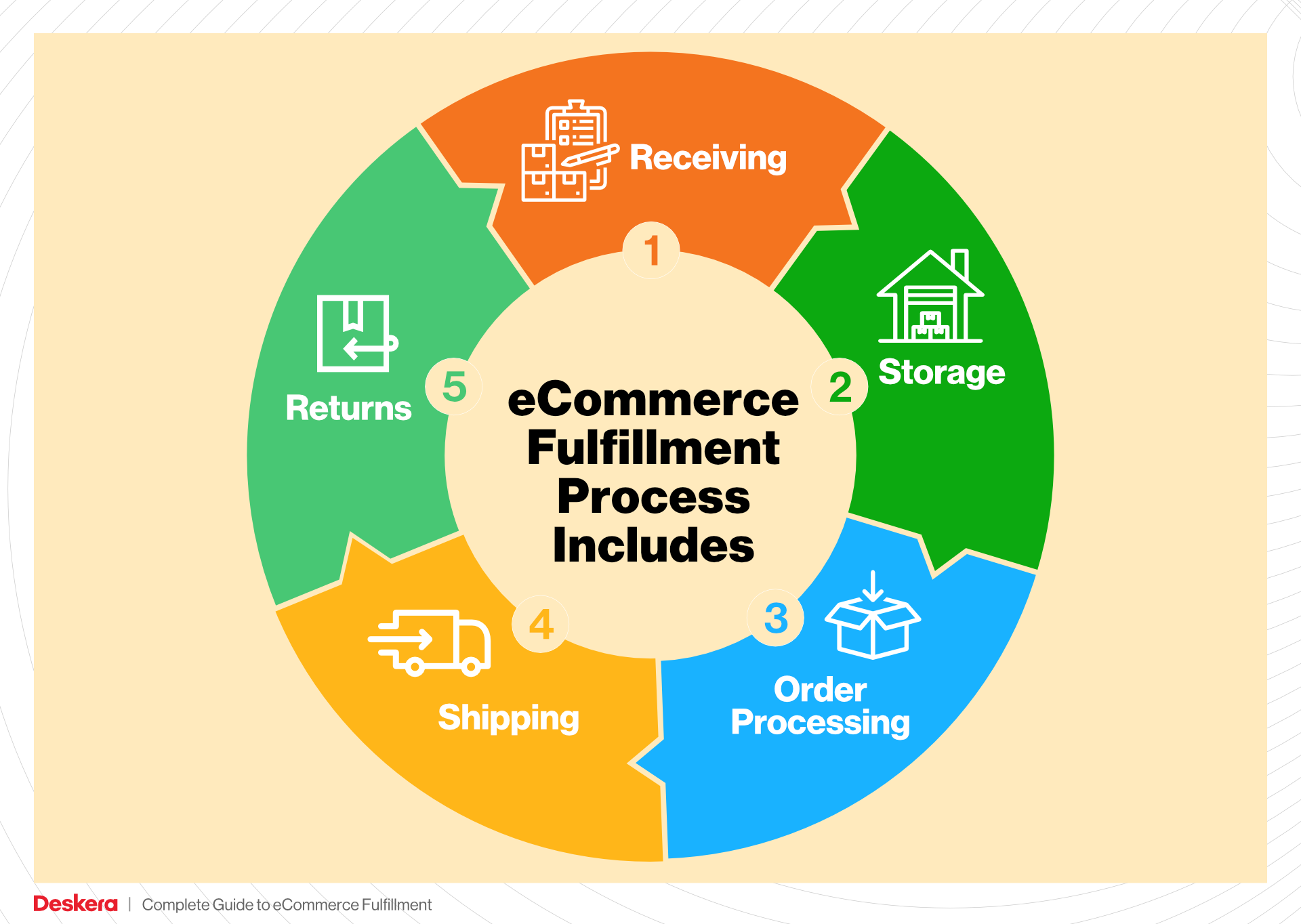
-
Pricing Structures: Finally, we’ll discuss the various pricing models you might encounter when engaging with fulfillment services. Understanding these costs is essential for budgeting and maximizing your profit margins.
Empowering Your Business Decisions
Our goal with this guide is to empower you to make smart, informed decisions about your logistics and fulfillment strategies. By understanding the intricacies of e-commerce fulfillment, you can streamline your operations, enhance customer satisfaction, and ultimately drive growth for your business. Let’s dive into the world of e-commerce fulfillment and discover how to effectively manage your logistics needs!
What You’ll Learn In This Guide
- What is E-commerce Fulfillment? An Introduction for Growing Businesses
- The Order Fulfillment Process: From ‘Buy’ Button to Customer’s Door
- Comparing Fulfillment Models: In-House vs. 3PL vs. Dropshipping
- A Deep Dive into Amazon FBA: Pros, Cons, and Who It’s For
- Core Services Offered by Fulfillment Centers
- How to Choose a Fulfillment Partner: A 6-Point Checklist
- Understanding Fulfillment Pricing: A Breakdown of Common Fees
- Frequently Asked Questions (FAQs) about Fulfillment
- Conclusion: Is Outsourcing Fulfillment the Right Move for Your Business?
- Important Disclaimer
The Order Fulfillment Process: From ‘Buy’ Button to Customer’s Door
1. Receiving Inventory
The order fulfillment process begins with receiving inventory from suppliers. This step is crucial as it ensures that the right products are available to meet customer demand. Upon arrival at the fulfillment center, goods are checked against purchase orders for accuracy in quantity and quality.
During this stage, key terms such as SKU (Stock Keeping Unit) come into play. Each item is assigned a unique SKU, which simplifies tracking and management of inventory. Proper documentation and logging into inventory management systems help maintain an accurate count of stock, which is vital for preventing stockouts and overstock situations. Efficient receiving processes reduce errors and lay a strong foundation for the entire fulfillment operation, allowing businesses to maintain a reliable supply chain.
2. Warehouse Storage
Once the inventory has been received and verified, the next step is warehouse storage. This involves organizing the products in a manner that maximizes space and facilitates easy access. Different storage methods can be employed, including shelving, pallet racking, and bin systems, depending on the types of products being stored.
An important concept in this stage is ABC analysis, which categorizes inventory based on the value and turnover rate of items. High-demand products (A items) are placed closer to the picking area for quicker access, while lower-demand items (C items) may be stored further away. Effective storage strategies not only optimize space but also streamline the picking process, ultimately enhancing efficiency and reducing fulfillment time.
3. Order Picking
Order picking is the process of retrieving items from storage to fulfill customer orders. This step is critical as it directly impacts order accuracy and customer satisfaction. Efficient picking methods can vary from batch picking (where multiple orders are picked at once) to zone picking (where pickers are assigned specific areas of the warehouse).
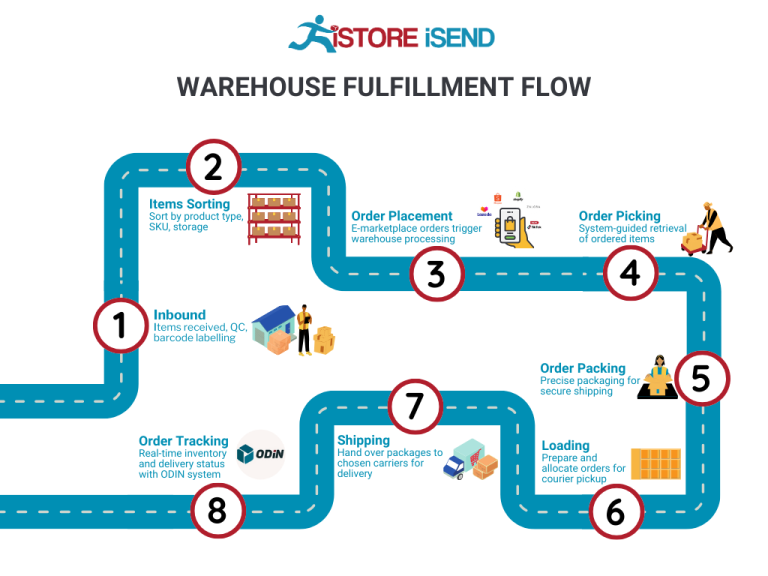
A key tool in this phase is the pick list, which outlines the items and quantities required for each order. Utilizing technology such as handheld scanners or mobile devices can further enhance accuracy and speed during picking. The effectiveness of this step significantly influences the overall order fulfillment cycle, as mistakes in picking can lead to delays, returns, and ultimately dissatisfied customers.
4. Order Packing
After items have been picked, they must be carefully packed for shipment. Packing is essential to protect products during transit and ensure they arrive in perfect condition. The packing process involves selecting appropriate packaging materials, labeling packages correctly, and including necessary documentation such as invoices and return instructions.
A critical term in this step is dimensional weight pricing, which considers both the size and weight of a package when calculating shipping costs. Understanding this concept helps businesses choose the right packaging to minimize costs while ensuring the safety of items. Effective packing not only enhances customer satisfaction through the delivery of undamaged goods but also plays a significant role in optimizing shipping expenses.
5. Shipping & Delivery
The final step in the order fulfillment process is shipping and delivery. This involves transferring packed orders to carriers for transportation to the customer’s location. Effective management of this stage is vital as it directly affects delivery times and costs.
Key considerations include selecting the right shipping method based on factors like delivery speed, cost, and destination. Businesses often utilize shipping software to streamline this process, integrating with carriers to automate label printing, tracking, and communication with customers. Timely and accurate delivery enhances customer experience and loyalty, making this step a critical component of the overall fulfillment strategy.
In conclusion, understanding and optimizing each step of the order fulfillment process—from receiving inventory to shipping and delivery—enables e-commerce businesses to scale effectively. By implementing best practices and utilizing technology, businesses can enhance efficiency, reduce costs, and ultimately provide a superior customer experience.
Comparing Fulfillment Models: In-House vs. 3PL vs. Dropshipping
Fulfillment Model Comparison
| Model | Who Handles Inventory | Best For (Business Stage) | Key Advantage | Key Disadvantage |
|---|---|---|---|---|
| In-House Fulfillment | The Business Itself | Startups to Established | Greater control over inventory and quality | Higher operational costs and complexity |
| Third-Party Logistics (3PL) | An External Provider | Growth Stage | Scalable solutions and expertise | Less control over inventory and potential delays |
| Dropshipping | Supplier or Manufacturer | Early Stage | Minimal upfront investment and risk | Lower profit margins and dependency on suppliers |
In-House Fulfillment
In-house fulfillment involves managing all aspects of inventory, warehousing, and shipping directly within your business. This model is ideal for businesses that have the resources to invest in warehouse space, personnel, and logistics management. Companies that choose in-house fulfillment typically benefit from greater control over their inventory, allowing them to maintain quality standards and respond swiftly to changes in demand. This model is particularly advantageous for brands that require a high level of customization in their packaging or shipping processes, as they can tailor these elements to enhance the customer experience. However, the key disadvantages include the high operational costs associated with maintaining a warehouse, staffing, and the complexity of managing logistics. As a business scales, the need for a sophisticated inventory management system and logistics strategy becomes paramount, which can strain resources if not carefully managed.
Third-Party Logistics (3PL)
Third-party logistics (3PL) providers offer a range of services, including warehousing, inventory management, and shipping, allowing businesses to outsource their logistics needs. This model is particularly beneficial for companies in the growth stage that are looking to scale their operations without the burden of managing logistics internally. By partnering with a 3PL, businesses can leverage the expertise and technology of logistics professionals, enabling them to focus on core business activities such as marketing and product development. The key advantage of using a 3PL is scalability; as your business grows, you can easily adjust the level of service you require without the need for substantial capital investment. However, the downsides include a potential lack of control over inventory and shipping processes, which can lead to delays or errors that negatively impact customer satisfaction. Businesses must also carefully select a reputable 3PL partner to ensure alignment with their operational needs and customer service expectations.
Dropshipping
Dropshipping is a fulfillment model where the retailer does not hold inventory but instead transfers customer orders directly to the supplier or manufacturer, who then ships the products directly to the customer. This model is particularly appealing for early-stage businesses or entrepreneurs looking to minimize upfront investments and operational risks. The primary advantage of dropshipping is that it requires little to no capital investment in inventory, allowing businesses to offer a wide range of products without the financial burden of purchasing stock. However, dropshipping comes with its own set of challenges, including lower profit margins due to reliance on suppliers and potential issues with inventory management and shipping times. Retailers must also contend with the risk of stockouts or quality issues, as they have less control over the fulfillment process. Consequently, while dropshipping can be an effective way to start an e-commerce venture, businesses need to carefully consider supplier reliability and the implications for customer experience.
Conclusion
Choosing the right fulfillment model is critical for the success of an e-commerce business. In-house fulfillment provides control and quality assurance but at a higher cost and complexity. Third-party logistics (3PL) offer scalability and expertise, making them ideal for growing businesses, but at the cost of some control. Dropshipping allows for a low-risk entry into the market but can lead to challenges with profit margins and supplier reliability. Each model has its strengths and weaknesses, and the decision should align with the business’s current stage, goals, and operational capabilities.
A Deep Dive into Amazon FBA: Pros, Cons, and Who It’s For
Understanding Fulfillment by Amazon (FBA)
Fulfillment by Amazon (FBA) is a logistics service provided by Amazon that allows sellers to store their products in Amazon’s fulfillment centers. Amazon then takes care of storage, packaging, and shipping of these products directly to customers. This service leverages Amazon’s vast network of warehouses and its expertise in logistics to streamline the selling process for e-commerce businesses, allowing them to focus on product development and marketing rather than the complexities of order fulfillment.
How FBA Works
- Product Listing: Sellers create product listings on Amazon and select which products they want to fulfill through FBA.
- Shipping to Amazon: Sellers ship their products to Amazon’s fulfillment centers. Amazon provides specific guidelines on how to prepare and package these shipments.
- Storage: Once products arrive at the fulfillment center, they are stored until an order is placed.
- Order Fulfillment: When a customer orders a product, Amazon picks, packs, and ships it directly to the customer. They also handle customer service and returns for these orders.
- Tracking and Management: Sellers can track their inventory and sales performance through the Seller Central dashboard, which offers insights into sales trends and inventory levels.
Pros of Using FBA
1. Prime Eligibility
One of the most significant advantages of FBA is that products fulfilled by Amazon are eligible for Amazon Prime. This means that Prime members can receive their products with free two-day shipping, which significantly increases the likelihood of sales. Studies show that Prime members tend to spend more on products that are eligible for Prime shipping.
2. Customer Trust
Amazon is synonymous with trust and reliability in e-commerce. By using FBA, sellers can leverage Amazon’s reputation for excellent customer service. Customers are more likely to purchase products that are fulfilled by Amazon, as they know they can rely on prompt delivery and efficient handling of any issues that arise.
3. Multi-Channel Fulfillment
FBA supports multi-channel fulfillment, allowing sellers to use Amazon’s logistics services to fulfill orders from other sales channels, such as their own websites or other marketplaces. This means that sellers can streamline their operations and maintain consistent inventory across multiple platforms without the need to invest heavily in their own logistics infrastructure.
Cons of Using FBA
1. High Fees
FBA can be costly, especially for new sellers or those with tight margins. Amazon charges various fees, including storage fees for the space your products occupy in their warehouses, and fulfillment fees for each unit sold. These fees can quickly add up, particularly if products do not sell quickly or if they are oversized or require special handling.
2. Strict Inventory Rules
Sellers must adhere to strict inventory management rules, including maintaining accurate stock levels and ensuring that products meet Amazon’s quality standards. Failure to comply can result in penalties or even the suspension of your seller account. Additionally, Amazon has policies regarding inventory age, and products that sit in their warehouses for too long can incur long-term storage fees.
3. Commingling Risks
FBA uses a commingling inventory system, meaning that your products are stored alongside those of other sellers. While this can streamline the fulfillment process, it also introduces risks. If your products are commingled with defective or counterfeit items from other sellers, it could damage your seller reputation and lead to customer complaints. Additionally, tracking down inventory issues can be more complex due to this system.

Who is FBA Best For?
FBA is an excellent choice for e-commerce businesses looking to scale their operations without investing heavily in their own logistics. It is particularly beneficial for:
- New Sellers: Those who are just starting their e-commerce journey can leverage Amazon’s infrastructure and customer base without needing to build their own fulfillment systems.
- Small to Medium-Sized Businesses: Brands that experience fluctuating demand and do not have the capacity to handle logistics in-house will find FBA’s scalability appealing.
- Sellers with High-Volume Products: Businesses that sell high-volume, fast-moving products can benefit from the efficiency and speed that FBA offers, maximizing their potential sales.
- Multi-Channel Retailers: Those who sell on various platforms and need a reliable fulfillment partner to streamline their logistics will find FBA’s multi-channel capabilities advantageous.
In conclusion, while FBA presents a streamlined solution for order fulfillment and access to Amazon’s vast customer base, sellers must carefully evaluate the associated costs and rules to determine if it aligns with their business model. By understanding both the advantages and the challenges, e-commerce businesses can make informed decisions about whether FBA is the right fit for their growth strategy.
Core Services Offered by Fulfillment Centers
Inventory Management & Warehousing
Fulfillment centers provide robust inventory management and warehousing services that are crucial for e-commerce businesses. This service involves the systematic storage of products, tracking of inventory levels, and management of stock replenishment. Fulfillment centers utilize sophisticated inventory management systems that allow businesses to monitor stock levels in real-time, ensuring that they have the right products available to meet customer demand.
Benefits:
1. Real-Time Visibility: Businesses gain access to real-time data about their inventory, which aids in making informed purchasing decisions and avoiding stockouts or overstock situations.
2. Space Optimization: Fulfillment centers are designed to maximize storage efficiency, allowing businesses to store more products without the need for additional warehouse space.
3. Cost-Effective Solutions: By outsourcing warehousing to a fulfillment center, e-commerce businesses can significantly reduce overhead costs associated with maintaining their own storage facilities, including rent, utilities, and labor.
Pick and Pack Services
Pick and pack services are a core function of fulfillment centers, involving the process of selecting items from inventory (picking) and packaging them for shipment (packing). This service is essential for ensuring that orders are accurately fulfilled and delivered to customers in a timely manner. Fulfillment centers often employ automated systems and trained staff to enhance the efficiency and accuracy of this process.
Benefits:
1. Accuracy in Order Fulfillment: With dedicated staff and technology, fulfillment centers minimize errors in order picking, which directly impacts customer satisfaction and retention.
2. Faster Turnaround Times: Streamlined pick and pack processes mean that orders can be processed quickly, allowing for faster shipping and delivery times, which are critical in today’s competitive e-commerce landscape.
3. Scalability: As a business grows, fulfillment centers can easily scale their pick and pack operations to handle increased order volumes without the need for significant investment in additional resources.
Kitting and Assembly
Kitting and assembly services offered by fulfillment centers involve grouping individual items into ready-to-ship sets or assembling products before they are shipped to customers. This can be particularly useful for businesses that offer bundled products, promotional kits, or complex items that require assembly before delivery.
Benefits:
1. Enhanced Product Offerings: Kitting allows businesses to create unique product bundles that can attract customers and increase average order value, making it a strategic marketing tool.
2. Efficiency in Operations: By outsourcing kitting and assembly to fulfillment centers, businesses can streamline their operations, allowing them to focus on core activities such as marketing and customer engagement.
3. Reduced Time to Market: Fulfillment centers equipped with the necessary tools and expertise can assemble products quickly, enabling businesses to respond rapidly to market demands and trends.
Returns Management (Reverse Logistics)
Returns management, also known as reverse logistics, is a vital service provided by fulfillment centers that handles the process of returns from customers. This includes receiving returned products, inspecting them, restocking them if they are in sellable condition, and managing the disposition of unsellable items. Effective returns management is crucial for maintaining customer satisfaction and loyalty.
Benefits:
1. Streamlined Return Processes: Fulfillment centers have established procedures for handling returns, which can significantly reduce the time and labor required for businesses to manage this complex process.
2. Improved Customer Experience: A hassle-free return process enhances the overall shopping experience, encouraging customers to make purchases with confidence, knowing they can easily return items if needed.
3. Data Insights: Analyzing return data can provide valuable insights into product performance and customer preferences, helping businesses make informed decisions about inventory and product offerings.
By leveraging these core services, e-commerce businesses can optimize their operations, enhance customer satisfaction, and ultimately scale their logistics capabilities to meet growing demand. Fulfillment centers act as strategic partners, enabling businesses to focus on growth while ensuring that their supply chain processes run smoothly and efficiently.
How to Choose a Fulfillment Partner: A 6-Point Checklist
Location & Warehouse Network
The geographic location of your fulfillment partner is crucial for optimizing shipping times and reducing costs. A partner with strategically located warehouses can significantly enhance your delivery speed, particularly for last-mile logistics.
Why It’s Important: Proximity to your customer base can lead to faster shipping times and lower shipping costs, both of which are vital for maintaining customer satisfaction and competitive pricing.
Questions to Ask:
– Where are your warehouses located, and how does that align with my target market?
– Do you have the capability to store inventory in multiple locations?
– How do you manage shipping logistics across different regions?
Technology & Integrations
In today’s digital landscape, a fulfillment partner’s technological capabilities can greatly impact your operational efficiency. The right technology ensures seamless integration between your e-commerce platform and the fulfillment center, facilitating real-time inventory tracking and order management.
Why It’s Important: Efficient technology can automate processes, reduce errors, and provide visibility into inventory levels, allowing for better decision-making and improved customer experiences.
Questions to Ask:
– What technology platforms do you use for inventory management and order processing?
– Can your system integrate with my existing e-commerce platform (e.g., Shopify, WooCommerce, Amazon)?
– Do you offer real-time tracking for both inventory and shipments?
Specializations (e.g., Cold Storage, Oversized Items)
Different businesses have unique needs based on the type of products they sell. Some fulfillment partners specialize in specific areas, such as cold storage for perishable goods or handling oversized items that require special logistics.
Why It’s Important: Choosing a partner with the right specialization ensures that your products are stored and handled correctly, reducing the risk of damage and ensuring compliance with industry regulations.
Questions to Ask:
– What types of products do you specialize in handling?
– Do you have facilities equipped for specific storage needs, such as cold storage or hazardous materials?
– How do you handle returns and damaged goods for specialized products?
Scalability & Capacity
As your business grows, your fulfillment needs will likely evolve. It’s essential to partner with a fulfillment provider that can scale operations to match your growth trajectory without compromising service quality.
Why It’s Important: A partner with scalable solutions can accommodate seasonal spikes in demand, new product launches, or expansion into new markets without requiring you to switch providers.
Questions to Ask:
– How do you manage scalability during peak seasons or unexpected demand surges?
– What is your current capacity, and how do you plan to expand in the future?
– Can you provide examples of how you’ve supported other businesses in scaling their operations?
Pricing and Contracts
Understanding the pricing structure and contract terms of a fulfillment partner is vital to ensure transparency and avoid unexpected costs. A clear pricing model allows you to budget effectively and assess the potential return on investment.
Why It’s Important: Hidden fees or complicated pricing structures can erode profit margins and complicate financial forecasting. It’s essential to understand what you are paying for and how those costs align with your business model.
Questions to Ask:
– What is included in your pricing model (e.g., storage fees, shipping costs, handling fees)?
– Are there any additional costs I should be aware of, such as for returns or special handling?
– Can you provide a sample contract for review, and are there flexible options for contract lengths?
Customer Support & Reviews
Effective customer support is key to resolving issues quickly and ensuring smooth operations. Additionally, reviews and testimonials from current or past clients can provide valuable insights into the fulfillment partner’s reliability and service quality.
Why It’s Important: Responsive customer support can help mitigate problems before they escalate, while positive reviews indicate a partner’s reliability and commitment to customer satisfaction.
Questions to Ask:
– What customer support options do you provide (e.g., phone, email, live chat)?
– How quickly can I expect a response to inquiries or issues?
– Can you share references or case studies from similar businesses you’ve worked with?
Conclusion
Choosing the right fulfillment partner is a critical decision that can significantly impact your e-commerce business’s efficiency, customer satisfaction, and overall growth. By evaluating potential partners against this checklist, you can make a well-informed decision that aligns with your operational needs and business objectives. Always ensure that you conduct thorough due diligence and consider both current needs and future growth when selecting a partner.
Understanding Fulfillment Pricing: A Breakdown of Common Fees
Initial Setup Fees
Initial setup fees are one-time charges incurred when establishing an account with a fulfillment center. These fees can vary significantly between providers but typically include costs associated with integrating your e-commerce platform with the fulfillment center’s systems, creating a unique inventory management plan, and onboarding your products into their system.
Calculating initial setup fees usually involves assessing the complexity of your business operations. For instance, if you have a large number of SKUs (Stock Keeping Units), the setup may require more time and resources, thus increasing the fee. On average, businesses can expect to pay anywhere from a few hundred to several thousand dollars based on their specific requirements.
Receiving Fees
Receiving fees are charged for the process of accepting and checking in your inventory at the fulfillment center. This fee typically covers the labor involved in unloading shipments, inspecting the goods, and entering them into the inventory system.
The calculation of receiving fees often depends on the volume and type of products being received. For instance, some fulfillment centers may charge a flat rate per shipment, while others might charge based on the number of pallets or boxes received. It is essential to clarify whether these fees are charged per item or a flat rate to avoid unexpected costs.
Storage Fees (per pallet/bin)
Storage fees are recurring charges for the space your inventory occupies within the fulfillment center. These fees can be calculated on a per pallet or per bin basis, depending on how the fulfillment center organizes its warehouse.
Storage fees typically consider factors such as the size of the pallet or bin and the duration of storage. For example, a standard pallet may incur a monthly fee ranging from $10 to $30, while smaller bins may have different pricing structures. Businesses should be aware of potential long-term storage fees that may apply if products remain unsold for extended periods. This fee can motivate businesses to maintain optimal inventory levels and enhance turnover rates.
Pick & Pack Fees (per item/order)
Pick and pack fees are charged for the service of selecting items from inventory, packing them for shipment, and preparing them for delivery. This fee is usually calculated based on the number of items in each order or the total number of orders processed.
The breakdown of pick and pack fees can vary widely. Some fulfillment centers may charge a flat fee per order, while others may have tiered pricing based on the number of items. For example, a fulfillment center might charge $1.50 for the first item and $0.50 for each additional item in the same order. Understanding the structure of these fees is crucial, as it directly impacts your operational costs, especially if you anticipate a high volume of orders.
Shipping Fees
Shipping fees are the costs associated with transporting the packaged orders to your customers. These fees can vary based on several factors, including the shipping method chosen (standard, expedited, etc.), the weight and dimensions of the package, and the destination.
Shipping fees can often be the most variable component of fulfillment pricing. Many fulfillment centers offer negotiated rates with major carriers, which can lead to cost savings for businesses. However, it’s important to clarify whether the shipping fees will be passed directly to you or if they are included in the pick and pack fees. Additionally, some fulfillment centers may charge a handling fee on top of the shipping fees, which should be factored into your overall logistics budget.
Tips for Getting an Accurate Quote
-
Define Your Needs: Clearly outline your business requirements, including the types of products, expected order volume, and any special handling needs. This will help fulfillment centers provide tailored quotes.
-
Request Itemized Pricing: Always ask for a detailed breakdown of fees. Itemized quotes will help you understand each cost component and avoid hidden charges.
-
Compare Multiple Providers: Don’t settle for the first quote. Compare several fulfillment centers to gauge competitive pricing and service offerings.
-
Inquire About Discounts: Some fulfillment centers may offer discounts for bulk orders or long-term contracts. Always ask about potential savings.
-
Review Terms and Conditions: Pay close attention to the terms related to storage, handling, and any penalties for changes in order volume. Understanding these terms can help you avoid unexpected fees in the future.
By understanding these common fulfillment pricing models and following the tips provided, e-commerce business owners can make informed decisions, ensuring their logistics operations are both cost-effective and efficient as they scale their businesses.
Frequently Asked Questions (FAQs) about Fulfillment
1. What is the SAT4 Amazon Fulfillment Center?
The SAT4 Amazon Fulfillment Center is a large distribution facility located in San Antonio, Texas. It plays a crucial role in Amazon’s logistics network, handling the storage, packaging, and shipping of products directly to customers. This facility is part of Amazon’s ongoing expansion to improve delivery times and enhance customer experience across the United States.
2. What is the difference between a warehouse and a fulfillment center?
A warehouse is primarily used for the storage of goods, often in bulk, until they are needed. In contrast, a fulfillment center specializes in processing orders, which includes picking, packing, and shipping products directly to customers. Fulfillment centers often have advanced technology and systems in place to manage inventory and expedite the order fulfillment process.
3. How do fulfillment centers improve shipping times?
Fulfillment centers like SAT4 are strategically located to minimize shipping distances to major markets. By using advanced logistics systems and automation, these centers can quickly process orders and prepare them for shipment, significantly reducing delivery times and enhancing customer satisfaction.
4. What services do fulfillment centers provide?
Fulfillment centers offer a range of services, including inventory management, order processing, packaging, shipping, and returns handling. Some centers also provide additional services such as kitting, labeling, and customized packaging to meet specific client needs.
5. What is a 3PL, and how does it relate to fulfillment?
A 3PL, or third-party logistics provider, is a company that offers outsourced logistics services, including warehousing and fulfillment. Many e-commerce businesses partner with 3PLs to leverage their expertise, technology, and infrastructure for managing inventory and shipping, allowing them to focus on core business activities.
6. How much do fulfillment services cost?
The cost of fulfillment services can vary widely based on several factors, including order volume, storage requirements, packaging needs, and shipping destinations. Typically, fulfillment centers charge a combination of storage fees (based on space used) and fulfillment fees (based on the number of orders processed). It’s essential for businesses to evaluate their specific needs and request quotes from multiple providers to find the best fit.
7. How does Amazon ensure the accuracy of orders in fulfillment centers?
Amazon employs sophisticated inventory management systems and automated technologies, such as barcode scanning and robotic picking systems, to ensure order accuracy. These technologies help minimize human error and streamline the picking and packing process, allowing for high levels of accuracy and efficiency.
8. Can small businesses use the SAT4 fulfillment center?
Yes, small businesses can leverage the SAT4 fulfillment center by utilizing Amazon’s Fulfillment by Amazon (FBA) program. This service allows small to medium-sized sellers to store their products in Amazon’s fulfillment centers, from where Amazon handles storage, packaging, and shipping on their behalf.
9. What are the benefits of using an Amazon fulfillment center?
Using an Amazon fulfillment center offers several benefits, including access to Amazon’s vast logistics network, faster shipping options like Prime, and increased visibility to millions of potential customers on the Amazon platform. Additionally, it allows businesses to scale operations without the need for significant upfront investment in warehousing and logistics infrastructure.
10. How can businesses optimize their fulfillment strategy?
To optimize their fulfillment strategy, businesses should analyze their order patterns, inventory turnover rates, and shipping destinations. Investing in technology to automate processes, partnering with reliable fulfillment centers, and continuously monitoring performance metrics can help businesses improve efficiency, reduce costs, and enhance customer satisfaction.
Conclusion: Is Outsourcing Fulfillment the Right Move for Your Business?
Assessing the Move to Outsource Fulfillment
Outsourcing fulfillment can be a game-changer for e-commerce businesses aiming for growth and efficiency. By leveraging a fulfillment service, you can save significant time that would otherwise be spent managing logistics, allowing you to focus on core business functions such as marketing and product development. This streamlined approach not only enhances operational efficiency but also enables quicker response times to market demands.
Scalability is another compelling advantage of utilizing a fulfillment partner. As your sales volume fluctuates—whether peaking during holiday seasons or expanding into new markets—an experienced fulfillment service can easily adapt to your changing needs. This flexibility ensures that you can meet customer expectations without the overhead costs associated with maintaining a large warehouse or hiring additional staff.
Moreover, partnering with a fulfillment expert provides access to specialized knowledge and technology that may not be feasible for a small or medium-sized business to develop in-house. These partners are often equipped with advanced inventory management systems, shipping solutions, and data analytics that enhance your logistics capabilities and improve customer satisfaction.
However, the success of outsourcing fulfillment hinges on selecting the right partner. It’s critical to assess potential providers based on their track record, technology, and alignment with your business goals. A misaligned partnership can lead to more challenges than solutions.
To determine if outsourcing fulfillment is the right next step for your business, conduct a thorough audit of your current shipping process. Evaluate your pain points and growth aspirations. This introspection will guide you in making an informed decision that positions your business for scalable success in the competitive e-commerce landscape.
Important Disclaimer
⚠️ Important Disclaimer
The information in this guide is for educational purposes. Fulfillment services, pricing, and platform features change frequently. Always conduct your own due diligence and consult with providers directly before making business decisions.
